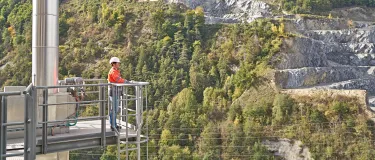Meet a bold new wave of carbon entrepreneurs
Find out how LafargeHolcim helps to bridge the gap between CO2 producer and CO2 consumer.
As the world debates how to take action against climate change during this year’s NY Climate week, there’s one technology that can enable industries to significantly reduce carbon emissions by the middle of the century: carbon capture.
The technology has been around for some time, but there have always been barriers to using it on a large scale, and it lacked a solid business case outside of oil recovery. Now though, there is an emerging group that sees opportunity in CO2. As part of this bold new wave of carbon entrepreneurs, LafargeHolcim is looking to the future of a carbon economy and the technologies that will power this change. “The time has come, and we have ambition,” says David Redfern, CEO of Eastern Canada. “We know that the world is changing, and we see a business opportunity in that change.”
Partnering with innovative companies is what will enable this change. As Redfern says, “We are willing to open up our cement plants, our quarries, to really figure out how new technologies can be put to work; and how this can be a commercial success.”
Case in point is Inventys; a young Canadian company that specializes in new carbon capture technologies, with the goal of bringing the captured CO2 into a carbon marketplace, rather than sequester it underground. “If we look at other uses of CO2,” says Brett Henkel, Co-founder and VP of Inventys, “such as concrete injection, fly ash injection, as well as CO2 to fuel, CO2 to plastics, and foods; generally, all of these uses need smaller capacities of CO2.”
The problem until today was that when you scale down CO2 supply to meet these needs, the cost goes up. “There is a challenge in the world, with matching the CO2 that is being produced from all sorts of sources with the CO2 needs of the utilization technologies that are emerging now.”
This is where Inventys steps in, to bridge the gap from CO2 producer to CO2 consumer. Their technology is based on solid adsorbents to capture CO2 at any scale required and is a cost-effective solution to this scaling problem. It is a collaborative effort between companies like Inventys, LafargeHolcim and Total, as well as downstream CO2 users. As Henkel puts it, “it actually isn’t that simple to capture CO2 from a cement plant, and utilization technologies are quite complicated. No one has really put those two technologies together. So we’ve organized a world-class collaboration of companies.”
The LafargeHolcim cement plant in Richmond, Canada will be the staging ground for this world-class collaboration. Here, the technology developed by Inventys will be tested and is expected to be fully operational by 2020. The technology will also prepare the carbon for reuse by a number of downstream users, who specialize in creating value from this CO2.
Companies such as CarbonCure and Carbon Upcycling are experts in creating value from what most people see as a waste product. Robert Niven, Founder and CEO of CarbonCure, explains: “CarbonCure adds CO2 into concrete during the mixing phase, where it reacts with the cement to form a nanomaterial that increases the strength of concrete. With higher-strength concrete, ready mix producers are able to adjust their mix designs and use less cement, which further reduces the carbon footprint of their concrete.
"This is the type of full integrated supply-chain model can really make this kind of solution scalable globally while providing economic advantages at the same time as substantial CO2 emissions reductions.”
While carbon capture is a way to carbon-neutral cement, it cannot operate in isolation and depends on mobilization at all levels. Action needs to come quickly though; a carbon capture capacity of 14 megatonnes of CO2 per year will be needed worldwide by 2030 to meet a 2° scenario, according to the IEA Cement Technology roadmap.






